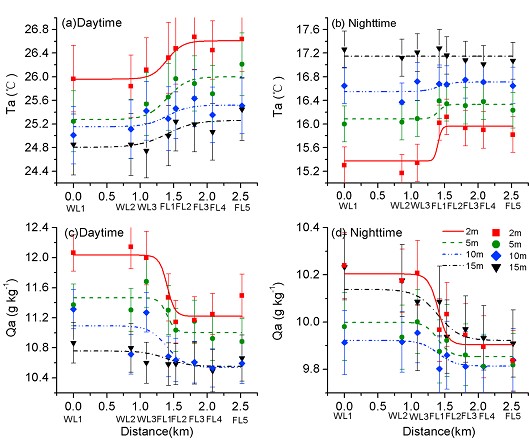The creation of wetland edges associated with anthropogenic fragmentation is common in wetland landscapes and brings about a unique microclimatic change that affects adjacent farmland. However, microclimatic edge effects within this kind of landscape are not well quantified. Thus, ecological remote sensing science team selected a study site located in the northeastern Sanjiang National Nature Reserve, China to investigate the spatiotemporal variations in the microclimatic variables of the surface layer across the wetland-farmland edge. They collected air temperature and specific humidity data continuously along a horizontal transect at four different heights over different periods, and used Sigmoid models to fit the horizontal gradients of microclimatic edge effects. Then, based on the parameters in the fitted models, the characteristics of the edge effects were quantified with two indices, the magnitude of edge effect (MEE) and the spatial range of edge effect (REE).
The results showed that under a light wind condition, the microclimatic features across the edge generally presented sigmoid ecological gradients in the horizontal direction, with unique spatial and temporal patterns. (1) In a normal year, wetland patches cooled and moistened the adjacent farmlands during the daytime and had a warming-moistening effect during the nighttime. (2) Vertically, the absolute MEE value of the microclimatic variables decreased, but the REE increased with increasing height(Fig.1). (3) The MEE and REE for air temperature and specific humidity varied with the time of day, both shifting at dawn and dusk when the gradients were absent. (4) At the interannual scale, when compared to the farmland, the wetland was cooler at night in a dry year but warmer in a normal year.
The detection of spatiotemporal microclimatic patterns in the wetland-farmland edge zone may enable further understanding of how wetland degradation affects adjacent farmland ecology under human disturbance and promote better management and restoration of fragmented wetlands.
Their investigation focused on quantifying the two-sided gradient patterns in microclimatic features from the wetland interior to the neighboring farmland interior. It differed from previous microclimatic edge effect studies, which have investigated mostly one-sided ecological gradients. The vast natural wetlands in Sanjiang Plain have been greatly transformed into a typical wetland-farmland landscape due to extensive human activities. Thus, their studies will enable further understanding of how wetland degradation affects themicroclimate in neighboring farmland; at the same time, it provides a scientific basis for the management and restoration of fragmented wetlands and farmland ecosystems and the protection of biodiversity.
The results were published in Journal of Geophysical Research-Atmospheres.

Figure 1. Vertical patterns of (a and b) air temperature (Ta, °C) during daytime and nighttime and (c and d) specific humidity (Qa, g kg-1) during daytime and nighttime across the wetland-farmland edge during 2008 at four heights.
Liao, X., Z. Liu, Y. Wang, and J. Jin (2013), Spatiotemporal variation in the microclimatic edge effect between wetland and farmland, J. Geophys. Res. Atmos., 118, 7640–7650, doi:10.1002/jgrd.50573.